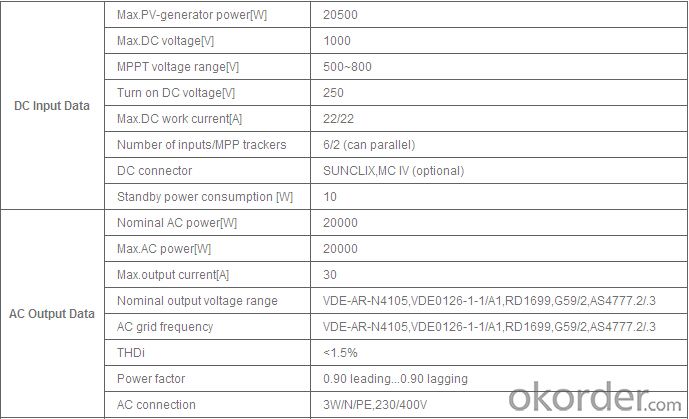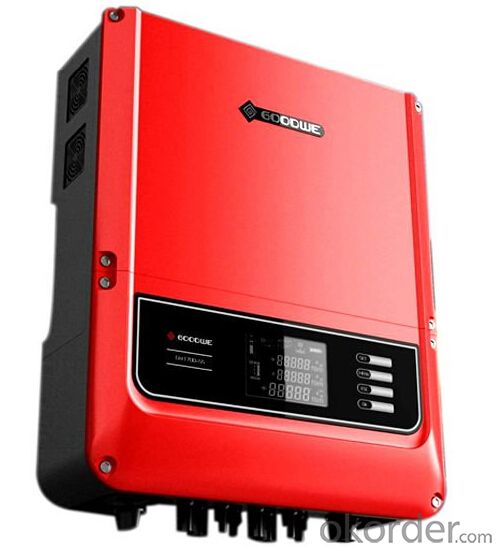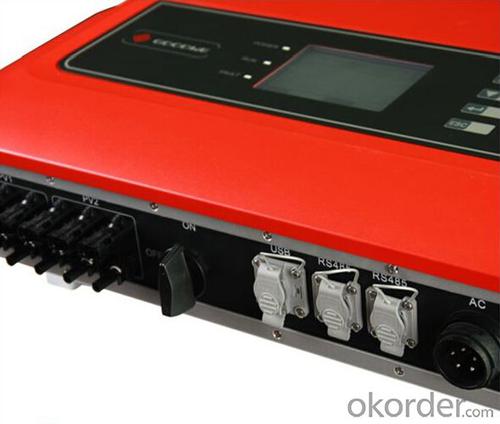Zamp Solar Inverter on Grid Solar Inverter .GW20K-DT
OKorder Service Pledge
OKorder Financial Service
You Might Also Like
GW17K-DT
GW20K-DT photovoltaic inverter is suitable for commercial and industrial roofs as well as small and medium-sized photovoltaic power systems.
Intelligent heat dissipation design ensures slower temperature rise and more stable running conditions.
The dual-lines MPPT extra-wide voltage range ensures that the system is with more flexible configuration.
Futures:
■ Maximum Efficiency up to 98.2%
■ 45℃ full-load output
■ European Efficiency up to 97.5%
■ Super large 5-inch LCD
■ MPPT Efficiency over 99.5%
■ 30% lighter than similar products
■ DC switch
■ Multiple monitoring and communication
■ IP65 dust-proof and water-proof rating
■ up to 800 pieces can be integrated in one system
Datasheet

- Q: What is the role of a solar inverter in preventing system failures?
- The role of a solar inverter in preventing system failures is to convert the direct current (DC) electricity generated by solar panels into alternating current (AC) electricity that can be used to power homes and businesses. In addition to this conversion, solar inverters also play a crucial role in ensuring the stability and efficiency of the entire solar power system. They monitor and regulate the voltage and frequency of the electricity being generated, protecting the system from overvoltage, undervoltage, and other electrical abnormalities that can potentially lead to system failures. By constantly monitoring and adjusting the electrical output, solar inverters help maintain the health and reliability of the solar power system, ultimately preventing potential failures and maximizing the overall performance.
- Q: What are the safety considerations when installing a solar inverter?
- Some safety considerations when installing a solar inverter include ensuring proper grounding and electrical connections, following manufacturer's guidelines and instructions, and having a licensed electrician perform the installation. It is also important to be cautious of potential electrical hazards and to handle the inverter with care to avoid any personal injuries.
- Q: What are the potential risks of short-circuiting a solar inverter?
- Short-circuiting a solar inverter can pose several potential risks. Firstly, it can cause damage to the inverter itself, leading to its malfunction or complete failure. Secondly, it can result in overheating of the inverter, which may increase the risk of fire or electrical hazards. Additionally, short-circuiting can disrupt the flow of electricity, potentially causing damage to other connected equipment or appliances. Lastly, it may void the warranty of the solar inverter, resulting in additional expenses for repairs or replacements. Therefore, it is crucial to take proper precautions and avoid short-circuiting the solar inverter to ensure its safe and efficient operation.
- Q: What is the role of a solar inverter in reactive power compensation?
- The role of a solar inverter in reactive power compensation is to regulate and control the flow of reactive power in a solar power system. Reactive power is the power that oscillates between the source and load due to the presence of inductive or capacitive elements in the system. It does not contribute to the actual work done by the system but is necessary for the operation of certain devices. A solar inverter, specifically designed for reactive power compensation, is capable of measuring the reactive power in the system and adjusting its operation accordingly. It can generate or absorb reactive power as required to maintain a power factor close to unity. Power factor is a measure of how efficiently the electrical energy is being used and a high power factor indicates efficient utilization of electricity. By compensating for reactive power, a solar inverter ensures that the solar power system operates at optimal efficiency. It reduces the burden on the grid by supplying or absorbing reactive power locally instead of relying on the grid for compensation. This not only improves the overall power quality but also reduces the losses in the system. Additionally, it helps to stabilize voltage levels and reduce voltage fluctuations, which can be beneficial for sensitive electrical equipment. In summary, the role of a solar inverter in reactive power compensation is to regulate the flow of reactive power in a solar power system, maintaining a high power factor and improving overall system efficiency. It plays a vital role in ensuring optimal operation of the solar power system and reducing the reliance on the grid for reactive power compensation.
- Q: How does a solar inverter handle fluctuations in solar panel output due to temperature changes?
- A solar inverter handles fluctuations in solar panel output due to temperature changes by employing a maximum power point tracking (MPPT) algorithm. This algorithm continuously monitors the output of the solar panels and adjusts the operating conditions of the inverter to extract the maximum power available. As temperature changes, the MPPT algorithm adapts the inverter's parameters to optimize the energy conversion process and ensure the highest possible efficiency. By dynamically adjusting the voltage and current levels, a solar inverter effectively mitigates the impact of temperature fluctuations on the solar panel's output.
- Q: What are the advantages of using a solar inverter?
- The advantages of using a solar inverter include the conversion of DC power from solar panels into AC power suitable for use in homes and businesses, the ability to sell excess electricity back to the grid, reduced reliance on fossil fuels, lower energy bills, and environmental benefits such as reduced carbon emissions.
- Q: Photovoltaic grid-connected inverter problem
- The first zero line is the AC output. Any AC output of the inverter will have zero line, whether it is isolated or non-isolated. Isolation is the safety of high voltage inverters and regulators. 50KW above the inverter almost with the transformer.
- Q: How does a solar inverter handle reactive power compensation?
- A solar inverter handles reactive power compensation by utilizing reactive power control techniques. It can dynamically regulate the amount of reactive power injected into or absorbed from the electrical grid. This helps maintain the power factor at the desired level, improving system efficiency and reducing grid instability caused by reactive power fluctuations.
- Q: What is the maximum efficiency of a solar inverter?
- The maximum efficiency of a solar inverter refers to the highest level of energy conversion achieved by the inverter, typically expressed as a percentage. It represents the amount of solar energy that is successfully converted into usable electricity by the inverter. The maximum efficiency can vary depending on the specific model and technology used, but modern solar inverters can typically achieve efficiencies ranging from 95% to 98%.
- Q: Can a solar inverter be used with micro-inverters?
- Yes, a solar inverter can be used with micro-inverters. Micro-inverters are typically used in small-scale solar installations to optimize the performance of individual solar panels. They convert the DC power generated by each solar panel into AC power, which can then be combined and synchronized by a central solar inverter. This allows for greater flexibility, efficiency, and monitoring capabilities in the overall solar system.
Send your message to us
Zamp Solar Inverter on Grid Solar Inverter .GW20K-DT
OKorder Service Pledge
OKorder Financial Service
Similar products
Hot products
Hot Searches
Related keywords
























